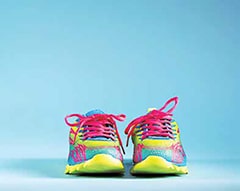You have to consider whether or not your feet are wide or narrow, whether you have a high arch or are flat-footed, and let’s not forget about pronation (how your foot rolls). Anyway, you get the point—there is an endless number of factors to consider when picking out athletic shoes. So where do you start? Kristie Delgado, MS, GMC’s Fitness Specialist provides some helpful tips:
Try some on.
But first, let’s get one common myth out of the way: shoes do not break in over time. If shoes don’t fit comfortably the first time you try them on, put them back and try on another pair—don’t wait for them to become comfortable.
Plus, when you choose to try on shoes can also be a deal breaker. That’s because your feet are actually different sizes throughout the day. Because of this, it’s best to wait until the end of the day, when your feet are their largest. And while it may not sound especially fun to go shoe shopping when you’re sweaty, it’s even better if you can try on athletic shoes post-workout, so you know how they’ll fit when your feet are swollen.
Find your fit.
• Buy a shoe one-half inch longer than your longest toe. “This could be as much as 1-1.5 sizes larger than your normal size,” explains Delgado.
• The forefoot should not be crowded. Be sure your toes can extend by wiggling them around. “That means you should be able to lift them up, and spread them out,” says Delgado. “Ditch any shoe that forces your toes to stay together.”
• Be sure there’s a snug fit around the heel of the shoe. “Remember, sometimes simply lacing the shoe differently can correct this,” notes Delgado.
• Your feet expand when bearing weight, so stand when your feet are measured. “Even better, do a few of the exercises you’ll be using the shoes for, whether that is running, jumping, or squatting, to check how they fit while you move,” emphasizes Delgado.
• In many people, 1 foot is larger than the other. Shoes should be fitted to your longer and wider foot. Although the toe box should be roomy, too much space can make your feet slide. This causes blisters.
Heel to Toe: Keeping You On The Go
While it can be slightly overwhelming to pick out the perfect pair of athletic shoes, not to mention find your perfect exercise routine, the experts at GMC’s Fitness & Performance Center can help. From answering common questions and helping you to overcome exercise obstacles to treating common injuries and helping you reach your fitness goals, you can count on GMC’s Sports Medicine Program.
Learn more by visiting gwinnettmedicalcenter.org/sports.


